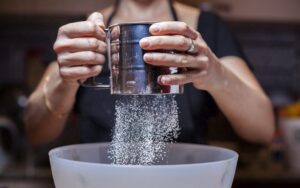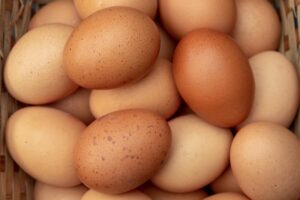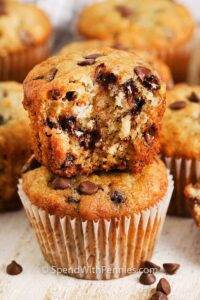Science of Recipe: Banana Chocolate Chip Muffins
Ingredients
- 1 1/2 cup flour
- 1 tsp baking soda
- 1/2 tsp salt
- 3/4 cup sugar
- 1 cup mashed bananas
- 1 large egg
- 1/2 cup vegetable oil
- 1 tsp vanilla extract
- 1/2 cup semi-sweet chocolate chips
- 1/4 cup milk chocolate chips
Instructions
- Preheat the oven to 375℉.
- Place paper liners in the muffin pan.
- Add both kinds of chocolate chips, the flour, salt, sugar, and baking soda into a bowl. Mix them together
- In another bowl add the egg, cup of mashed bananas, vegetable oil, and vanilla extract.
- Combine the two bowls by slowly adding the dry ingredients into the wet ingredient bowl. Mix slowly and do not over mix.
- Pour the ingredients evenly into the paper liners in the muffin pan.
- Bake the muffins for 18-20 minutes or until a toothpick can come out of the muffin clean.
- Let cool for 5-10 minutes. Enjoy!
Recipe Notes
Science of the Ingredients:
 Reference: Taste of Home
Flour: The flour used in this recipe is all-purpose. It is used as a structure builder in this case, providing carbohydrates and proteins. The proteins that it provides include glutenin and gliadin, which are essential in order for gluten formation to occur. When these proteins are mixed with the water from the eggs, gluten will begin to form.
Reference: Taste of Home
Flour: The flour used in this recipe is all-purpose. It is used as a structure builder in this case, providing carbohydrates and proteins. The proteins that it provides include glutenin and gliadin, which are essential in order for gluten formation to occur. When these proteins are mixed with the water from the eggs, gluten will begin to form.
 Reference: Medical News
Egg: These primarily serve as a structure builder in this recipe. The egg whites mainly provide proteins to the recipe, which helps create binds between the different ingredients. On the contrary, the egg yolk is mostly composed of fats, which tend to weaken the structure of a baked good. Additionally, the egg as a whole acts as an emulsifier. This means it serves as a way for fats and water to mix, which would not occur without an emulsifier present. Finally, the eggs serve as the water source for this recipe, as they are composed of nearly 75% water.
Reference: Medical News
Egg: These primarily serve as a structure builder in this recipe. The egg whites mainly provide proteins to the recipe, which helps create binds between the different ingredients. On the contrary, the egg yolk is mostly composed of fats, which tend to weaken the structure of a baked good. Additionally, the egg as a whole acts as an emulsifier. This means it serves as a way for fats and water to mix, which would not occur without an emulsifier present. Finally, the eggs serve as the water source for this recipe, as they are composed of nearly 75% water.
 Reference: GF Food Service
Vegetable Oil: The liquid state of the oil creates moisture inside of the muffin. Since oil is liquid at room temperature it cannot act as a leavening agent there for making a more dense muffin. After the muffin is created and stored in a fridge, a muffin made from oil will not need to be thawed to become firm again. Oil reacts in a certain way with the colder temperature to keep the muffin at the same density.
Reference: GF Food Service
Vegetable Oil: The liquid state of the oil creates moisture inside of the muffin. Since oil is liquid at room temperature it cannot act as a leavening agent there for making a more dense muffin. After the muffin is created and stored in a fridge, a muffin made from oil will not need to be thawed to become firm again. Oil reacts in a certain way with the colder temperature to keep the muffin at the same density.
 Reference: Spruce Eats
Baking Soda: This serves as the main leavening agent in this recipe. Baking soda is a basic substance with a PH of about 8. Since it only has basic qualities, the baking soda will need an acidic substance to be added to the recipe in order to activate. When an acid is added, the baking soda will begin to neutralize it and will create CO2 in the process. This release of CO2 creates the rising effect that is needed to create an aesthetically pleasing muffin.
Reference: Spruce Eats
Baking Soda: This serves as the main leavening agent in this recipe. Baking soda is a basic substance with a PH of about 8. Since it only has basic qualities, the baking soda will need an acidic substance to be added to the recipe in order to activate. When an acid is added, the baking soda will begin to neutralize it and will create CO2 in the process. This release of CO2 creates the rising effect that is needed to create an aesthetically pleasing muffin.
 Reference: Eat This
Sugar: In this recipe, sugar creates the potential for Maillard Browning. A little bit of browning will create a more desirable color for the muffin than a pale color.
Step by Step Science:
Reference: Eat This
Sugar: In this recipe, sugar creates the potential for Maillard Browning. A little bit of browning will create a more desirable color for the muffin than a pale color.
Step by Step Science:

- Adding the paper liners to the muffin pan will ensure that the muffins do not stick to the pan once they are cooked. Using the muffin liners also ensures that you do not have to grease the pan before putting in the batter.
- When the wet ingredients and the dry ingredients mix together and the flour begins to mix with the water, gluten begins to form as a reaction between the two. This is a result of the glutenin and gliadin coming in contact with water. These are the three components that are required for gluten formation to begin. Additionally, the wet ingredients contain water from the eggs. The water acts as an acid in this recipe and will allow the baking soda to begin its leavening process when the two ingredients are introduced. Once the two are combined, the baking soda will begin to release CO2, and that is where you will get most of the leavening from.
- It is important not to over mix the batter once they are combined. Over Mixing the batter can cause extra gluten development, which would lead to a chewier muffin. There is a small amount of water in the recipe to limit the gluten formation, so over mixing will harm the muffins.

- Using a liquid fat like vegetable oil is important if you want a dense and moist muffin. Vegetable oil stays in its liquid state at room temperature and will continue to provide more moisture for the muffin compared to a solid fat.
- When cooking the muffins in the oven, the muffins are being cooked by convection. When convection is used, the warm air is able to cook the muffins from all sides. This will ensure that muffin is cooked all the way through evenly.
- In this recipe, we used an unsaturated fat instead of a saturated fat. Using oil instead of a solid fat like butter allowed us to see how the texture and the density of the muffin would change. As a result of the oil staying in its liquid form at colder temperatures, the muffins that are made with vegetable oils keep better in the fridge. The butter made muffins will harden up when left in the fridge, while the vegetable oil muffins maintain their texture and moistness.